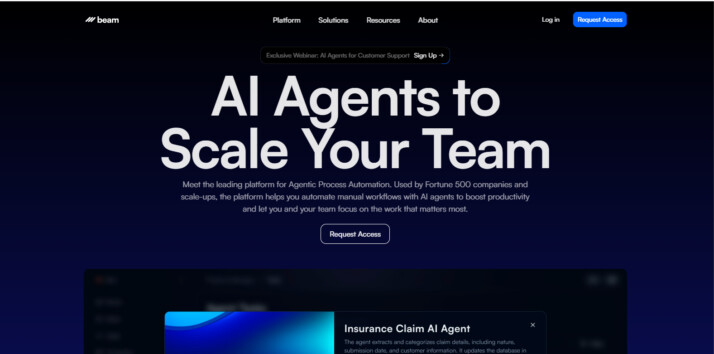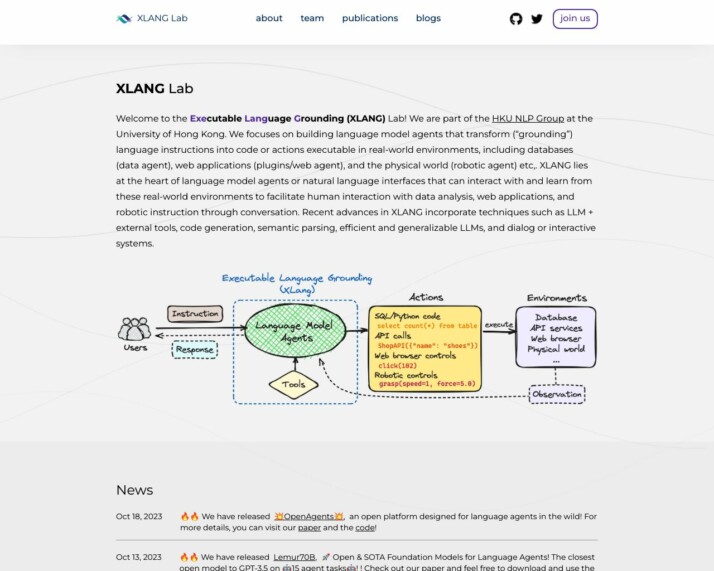Beam AI vs. OpenAgents: Enterprise AI vs. Open-Source Automation
AI agents have revolutionized business operations, automating complex tasks and enhancing productivity. This comparison explores Beam AI vs. OpenAgents, two innovative platforms reshaping AI agent development. Beam AI focuses on enterprise-grade generative AI for task automation, while OpenAgents offers an open-source solution with specialized agents for data analysis, web browsing, and plugin integration. We’ll examine their unique features, strengths, and limitations to help you determine which platform best suits your AI development needs. We’ll also introduce SmythOS, a comprehensive solution that combines the best of both worlds with advanced features and user-friendly design.
Beam AI Overview
Beam AI specializes in developing generative AI agents that automate repetitive tasks and enhance productivity within organizations. These autonomous agents, known as Agentic Process Automations (APA), excel at performing complex workflows more efficiently than humans. Beam AI focuses on key areas such as data extraction, customer inquiry management, compliance automation, and order optimization.


The platform’s AI agents continuously learn and adapt, improving their accuracy and efficiency over time. This makes them particularly effective for back-office automation, customer service, compliance tasks, and order processing. Beam AI’s approach centers on sustainability, aiming to streamline processes and reduce human carbon footprints through intelligent automation.
Beam AI specializes in developing generative AI agents that automate repetitive tasks and enhance productivity within organizations.
Beam AI’s agents feature advanced conversational interfaces, enabling seamless interaction with users and efficient task management. They integrate with existing internal systems to plan and execute workflows, providing a comprehensive automation solution. The platform emphasizes speed and efficiency, designed to save time and enhance productivity across various business operations.
While Beam AI offers robust features for AI agent deployment and management, it lacks some capabilities found in other platforms. The absence of a visual builder or no-code editor may limit accessibility for non-technical users. Additionally, the platform does not appear to support multimodal interactions or provide a hosted vector database, which could restrict its versatility in certain use cases.
OpenAgents Overview
OpenAgents offers an innovative open-source platform for creating, hosting, and managing AI agents. The system centers on three specialized agents: Data Agent for complex data analysis, Plugins Agent with over 200 integrated tools, and Web Agent for autonomous web browsing.
The Data Agent excels at processing large datasets and generating insights, making it invaluable for data-intensive roles like marketing. The Plugins Agent’s extensive library enables it to handle a wide variety of daily tasks, from checking weather to online shopping. The Web Agent, equipped with a Chrome extension, streamlines internet navigation by automating website exploration.
OpenAgents emphasizes user-friendliness with a web UI and backend server that facilitate easy communication with the agents. This design philosophy makes advanced AI capabilities accessible to non-expert users, bridging the gap between technical complexity and practical application.


OpenAgents emphasizes user-friendliness … making advanced AI capabilities accessible to non-expert users, bridging the gap between technical complexity and practical application.
The platform’s strengths lie in its versatility and focus on real-world problem-solving. By integrating AI agents into daily life, OpenAgents aims to provide tangible solutions for data analysis, web browsing, and task automation. However, the open-source nature of the platform may require users to have some technical knowledge for optimal utilization.
While OpenAgents offers powerful tools for AI integration, it may lack some of the more advanced features found in enterprise-grade solutions, such as extensive scalability options or built-in debugging tools. Users seeking a highly customizable, open-source solution for AI agent development will find OpenAgents a compelling option, particularly if they value flexibility and community-driven innovation.
Feature Comparison
Beam AI and OpenAgents offer distinct approaches to AI agent development, with notable differences in their core components and security features. Beam AI excels in creating generative AI agents for task automation and productivity enhancement, particularly in enterprise settings. Its agents continuously learn and adapt, improving efficiency over time. In contrast, OpenAgents provides an open-source platform centered around three specialized agents: Data Agent, Plugins Agent, and Web Agent, catering to data analysis, task automation, and web browsing respectively.
While both platforms support autonomous agents and multi-agent collaboration, Beam AI lacks a visual builder or no-code editor, potentially limiting accessibility for non-technical users. OpenAgents, on the other hand, emphasizes user-friendliness with a web UI, making it more accessible to a broader audience. In terms of security, Beam AI offers robust features including data encryption, OAuth support, and IP control. OpenAgents’ open-source nature may require users to implement their own security measures.
A significant gap exists in multimodal capabilities and hosted vector database support. Beam AI does not offer these features, which could restrict its versatility in handling diverse data types. OpenAgents, while strong in data analysis and web interaction, also lacks explicit mention of these capabilities. This gap may impact users requiring advanced data processing and storage solutions for their AI agents.
Feature Comparison Table
| Beam AI | OpenAgents | SmythOS | |
|---|---|---|---|
| CORE FEATURES | |||
| Visual Builder | ❌ | ❌ | ✅ |
| No-Code Options | ❌ | ❌ | ✅ |
| Debug Tools | ❌ | ✅ | ✅ |
| Multimodal | ❌ | ✅ | ✅ |
| Agent Work Scheduler | ✅ | ❌ | ✅ |
| SECURITY | |||
| Constrained Alignment | ✅ | ❌ | ✅ |
| IP Control | ✅ | ❌ | ✅ |
| COMPONENTS | |||
| Data Lakes | ❌ | ❌ | ✅ |
| DEPLOYMENT OPTIONS (EMBODIMENTS) | |||
| Staging Domains | ✅ | ❌ | ✅ |
| Production Domains | ✅ | ❌ | ✅ |
| Deploy as Scheduled Agent | ✅ | ❌ | ✅ |
| DATA LAKE SUPPORT | |||
| Hosted Vector Database | ❌ | ❌ | ✅ |
| Sitemap Crawler | ❌ | ❌ | ✅ |
| YouTube Transcript Crawler | ❌ | ❌ | ✅ |
| URL Crawler | ❌ | ✅ | ✅ |
Best Alternative to Beam AI and OpenAgents
SmythOS stands out as the superior alternative to Beam AI and OpenAgents, offering a comprehensive platform for AI agent development and deployment. We’ve designed SmythOS to address the limitations of other platforms while providing unparalleled flexibility and ease of use.
Our visual builder sets SmythOS apart from Beam AI and OpenAgents. While these competitors lack intuitive no-code options, we empower users of all skill levels to create sophisticated AI agents through our drag-and-drop interface. This democratization of AI development allows businesses to rapidly prototype and deploy custom solutions without extensive coding knowledge.
SmythOS excels in its extensive feature set compared to Beam AI and OpenAgents. We offer robust multimodal capabilities, enabling AI agents to process and generate various data types including text, images, and audio.
SmythOS excels in its extensive feature set compared to Beam AI and OpenAgents. We offer robust multimodal capabilities, enabling AI agents to process and generate various data types including text, images, and audio. Our platform also provides a hosted vector database, sitemap crawler, and YouTube transcript crawler — features absent in both Beam AI and OpenAgents. These tools allow for more comprehensive data ingestion and analysis, enhancing the capabilities of AI agents built on our platform.
The versatility of SmythOS truly shines in its deployment options. Unlike OpenAgents, which lacks production deployment features, we provide staging and production domains, scheduled agent deployment, and the ability to deploy as APIs, webhooks, or chatbots. This flexibility ensures that AI solutions built with SmythOS can be seamlessly integrated into existing workflows and scaled as needed. Our platform’s adaptability makes it suitable for a wide range of use cases, from simple task automation to complex enterprise-level AI implementations.
In terms of security and scalability, SmythOS outperforms both competitors. We implement robust security measures including constrained alignment and IP control, features missing from OpenAgents. Additionally, our scalable architecture supports enterprise-level deployments, addressing limitations in Beam AI’s offerings. With SmythOS, businesses can confidently develop and deploy AI agents knowing their solutions are secure, scalable, and built for long-term success.
Conclusion
Beam AI and OpenAgents each offer unique approaches to AI agent development, but SmythOS stands out as the superior choice for businesses seeking a comprehensive, user-friendly platform. While Beam AI excels in task automation and OpenAgents provides specialized agents for data analysis and web browsing, SmythOS delivers unparalleled versatility and ease of use.
SmythOS’s drag-and-drop interface and extensive integration ecosystem empower users to create sophisticated AI workflows without extensive coding knowledge. This democratization of AI development makes it accessible to a broader audience, from developers to business users. The platform’s support for multi-agent orchestration and versatile deployment options, including integration with popular services like Google Vertex and Amazon Web Services Bedrock, ensures seamless incorporation into existing systems.
Unlike its competitors, SmythOS offers a complete suite of features including visual building, no-code editing, and robust security measures. Its ability to handle multimodal interactions and provide a hosted vector database addresses limitations found in both Beam AI and OpenAgents. This comprehensive approach allows businesses to tackle complex challenges across various industries efficiently.
To experience the transformative power of SmythOS for yourself, create a free account today. With our risk-free trial offering unlimited agents and a 30-day money-back guarantee, you can explore how SmythOS can revolutionize your AI workflow. Discover our extensive library of AI agent templates to jumpstart your projects and unlock the full potential of AI for your business.
Last updated:
Disclaimer: The information presented in this article is for general informational purposes only and is provided as is. While we strive to keep the content up-to-date and accurate, we make no representations or warranties of any kind, express or implied, about the completeness, accuracy, reliability, suitability, or availability of the information contained in this article.
Any reliance you place on such information is strictly at your own risk. We reserve the right to make additions, deletions, or modifications to the contents of this article at any time without prior notice.
In no event will we be liable for any loss or damage including without limitation, indirect or consequential loss or damage, or any loss or damage whatsoever arising from loss of data, profits, or any other loss not specified herein arising out of, or in connection with, the use of this article.
Despite our best efforts, this article may contain oversights, errors, or omissions. If you notice any inaccuracies or have concerns about the content, please report them through our content feedback form. Your input helps us maintain the quality and reliability of our information.
